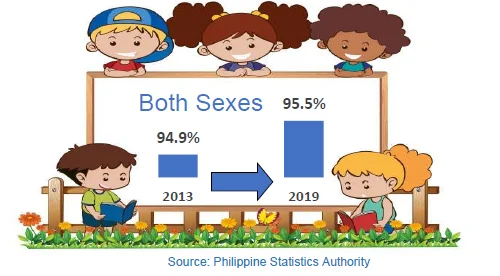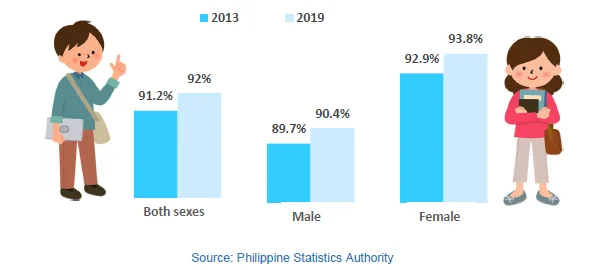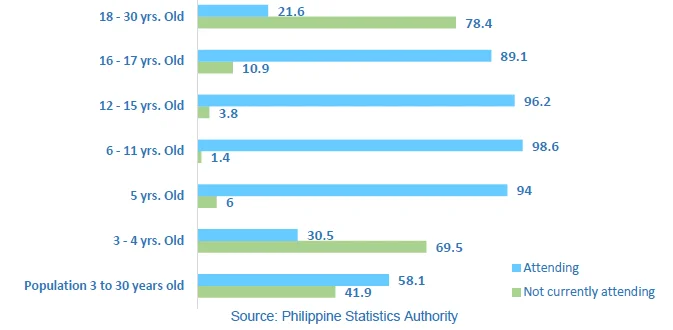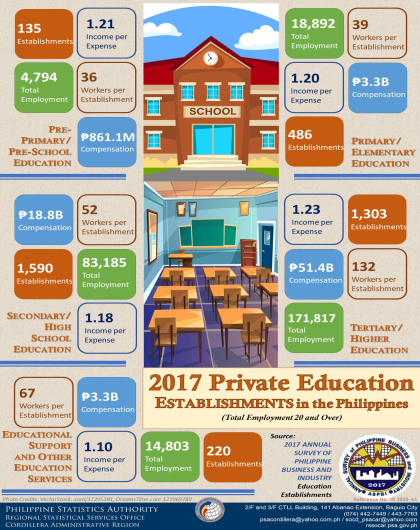The 2019 FLEMMS provides highlights on: 1.) the highest educational attainment and basic literacy status of the population 5 years old or over; 2.) functional literacy status of the population 10 to 64 years old; and .3) exposure to the different forms of mass media.
2nd region with the most resident who reach at least college level or higher
- Among regions, CAR ranked second as the region with the most residents who reached at least college level or higher with 2.1 percent difference from that of the National Capital Region (NCR), the region with most residents who had at least a college level or higher education.
| Population 5 Years old and Over |
Population 5 years old and over (with answer in HEA)
|
No grade completed/ Early Childhood Education
|
College graduate or higher
|
|
|---|---|---|---|---|
| Philippines | 96,750 | 95,933 | 7.1 | 11.8 |
| CAR | 1,615 | 1,583 | 7.0 | 15.5 |
CAR LITERACY
- Basic or simple literacy is the ability of a person to read and write with understanding a simple message in any language or dialect. In 2019, 96.5 percent of 86 million Filipinos 10 years old and over nationwide were basically literate. Basic literacy rate in the Philippines remained the same as during the two periods.
- In CAR, basic or simple literacy of population 10 years old and slightly increased to 95.5 percent in 2019 as compared to 94.9 percent in 2013. In 2019, there were more females (96.0 percent) who can read and write than the males (95.1 percent), with 0.9 percent difference.

- From the 13th spot as the most literate region in the Philippines in 2013, the Cordillera region climbed up to the 7th spot in 2019 as the region with the most literate population among regions in the country.
| 2019 Basic Literacy Rate (in Percent) | 2013 Basic literacy rate (in percent) | |||||
| Both Sexes | Male | Female | Both Sexes | Male | Female | |
| Philippines | 96.5 | 95.9 | 97.1 | 96.5 | 96.1 | 97.0 |
| Cordillera Administrative Region (CAR) | 95.5 | 95.1 | 96.0 | 94.9 | 94.8 | 94.9 |
9 in 10 Cordilleran are functionally literacy
- Functional literacy is a significantly higher level of literacy which includes not only reading and writing skills but also numeracy skills. In CAR, the functional literacy rate from 2013 slightly increased in 2019 by 0.8 percentage point. This was from the record of 91.2 percent functional literacy rate in 2013 to 92.0 percent in 2019. This was slightly higher than the overall functional literacy rate of 91.6 percent in the country in 2019.
- Female Cordillerans 10 to 64 years old were more functionally literate than the males in 2019. As compared to 2013, there were more females (93.8 percent) who had higher numeracy skills than the males (90.4 percent) in 2019. Functional literacy among males and females in 2013 were at 89.7 percent and 92.9 percent, respectively.

| 2019 Functional Literacy Rate (in Percent) | 2013 Functional Literacy rate (in percent) | |||||
| Both Sexes | Male | Female | Both Sexes | Male | Female | |
| Philippines | 91.6 | 90.2 | 92.9 | 90.3 | 88.7 | 92.0 |
| Cordillera Administrative Region (CAR) | 92.0 | 90.4 | 93.8 | 91.2 | 89.7 | 92.9 |
- In terms of school attendance, almost six in ten of the population (58.1 percent) 3 to 30 years old were currently attending school in 2019 in the Cordillera region, while 41.9 percent were not.
- The age group with the highest number of persons not attending school belong to the age groups 3 to 4 years old and 18 to 30 years old with a percentage of 69.5 and 78.4, respectively.
- By level of education, most of the population 3 to 30 years old were in the elementary level with 37.5 percent, followed by Junior High School with 28.7 percent, and Senior High School lwith 11.1 percent. Meanwhile, about 10.9 percent reached College level, while only 0.3 percent were College graduates or had tertiary education.

- The age group 6 to 11 years old recorded the highest number of attendance in school with 98.6 percent, followed by the age groups 12 to 15 years old with 96.2 percent, 5 years old with 94.0 percent, and 16 to 17 years old with 89.1 percent.


